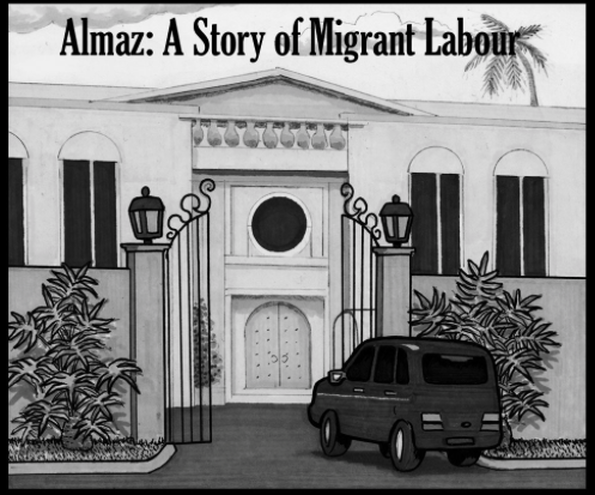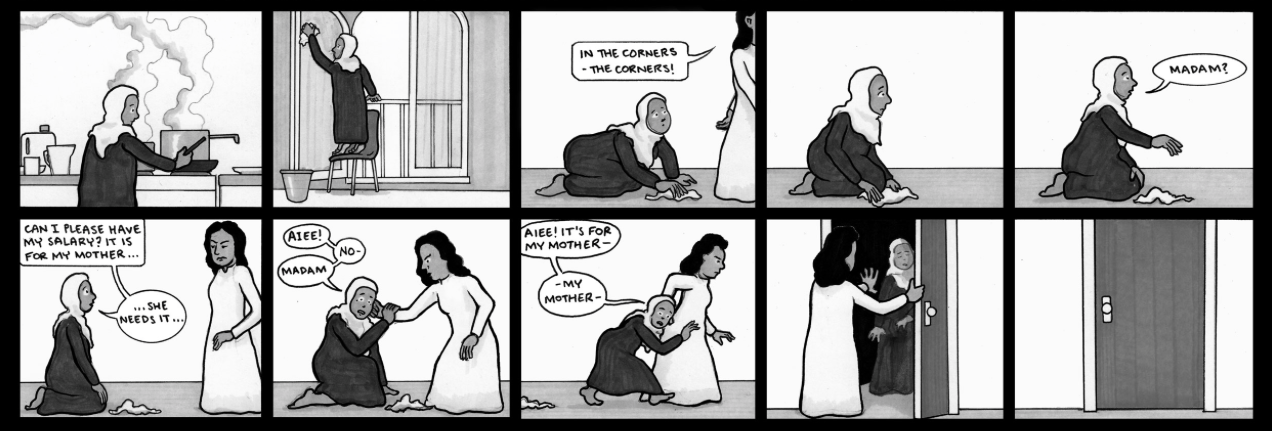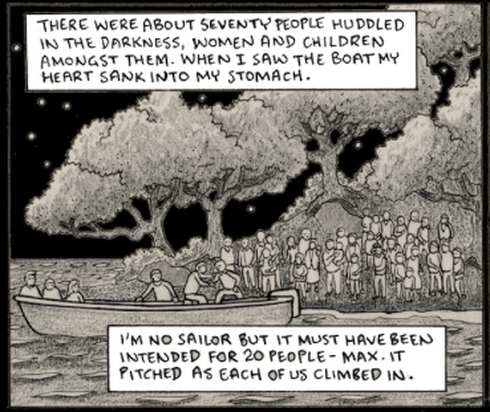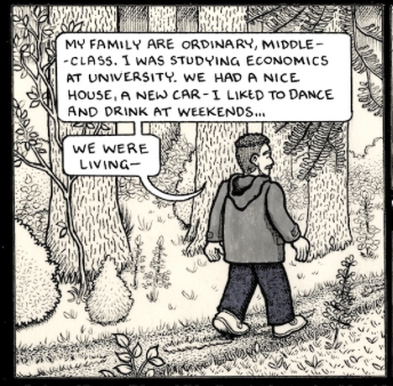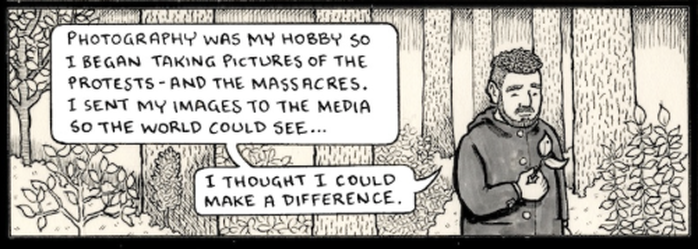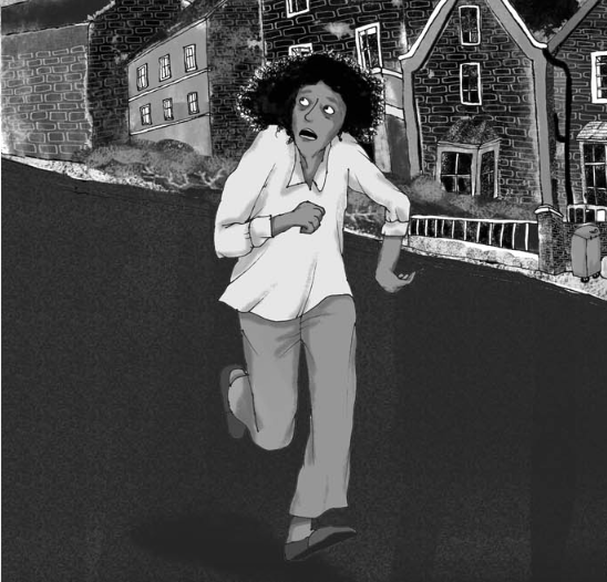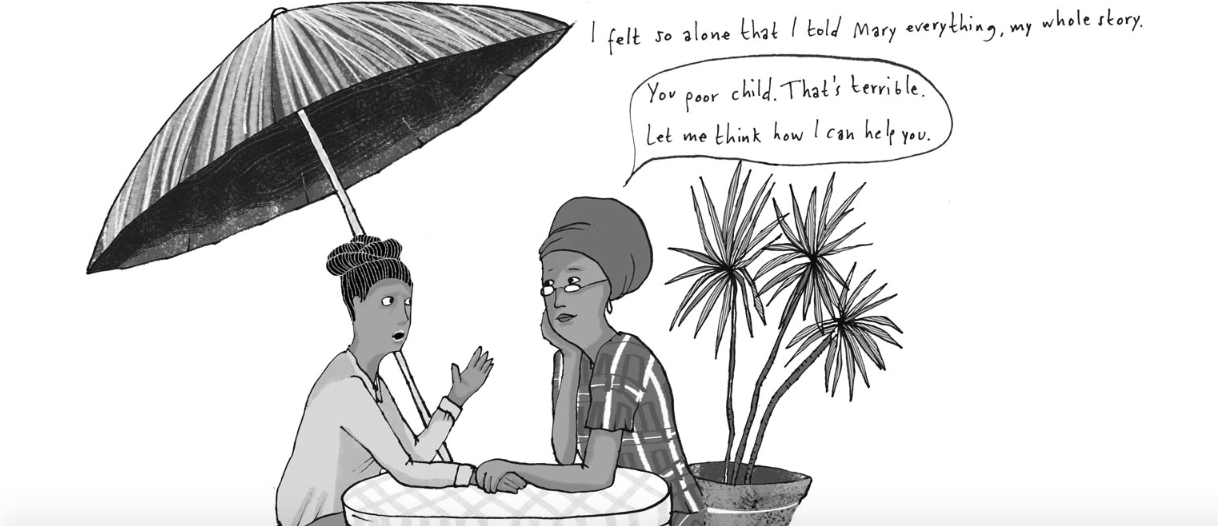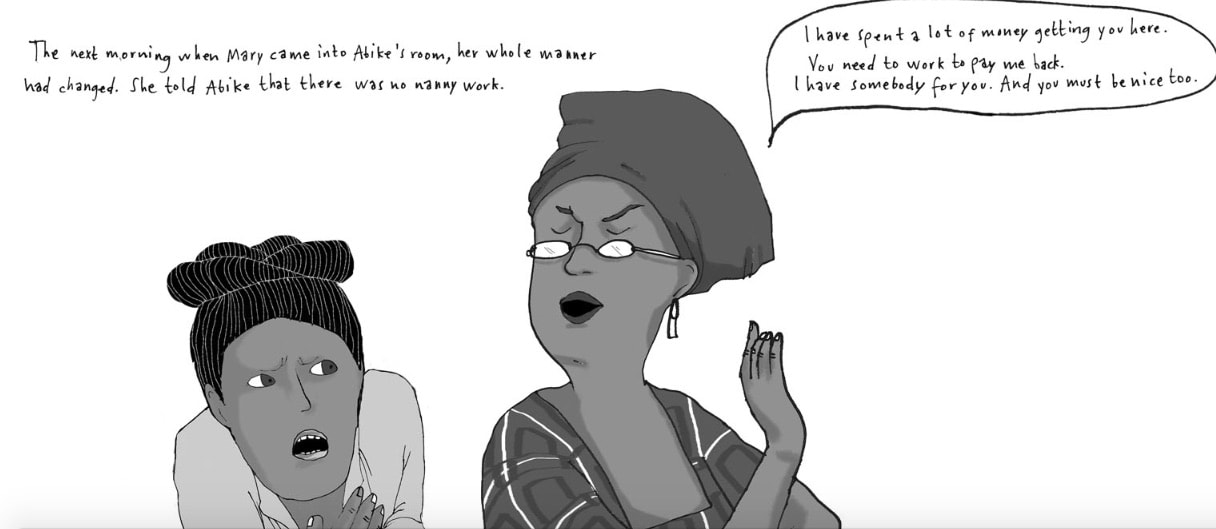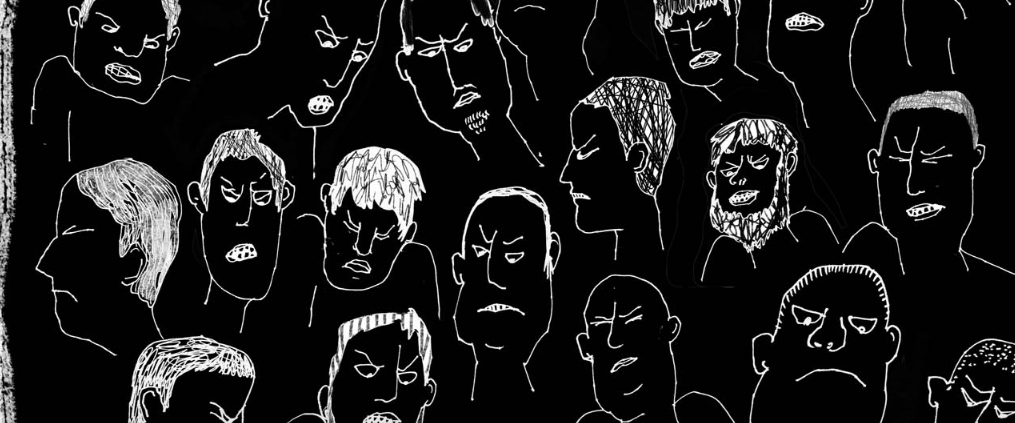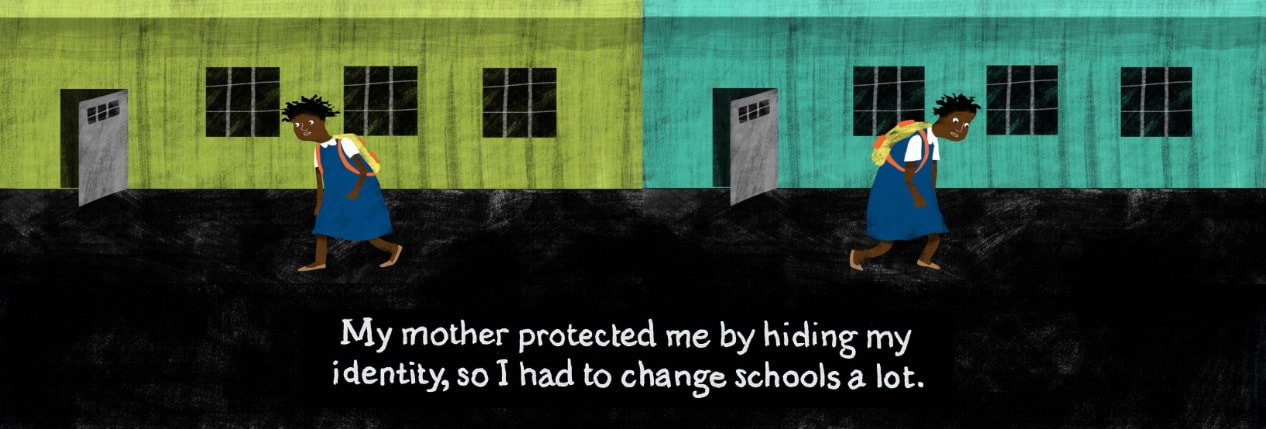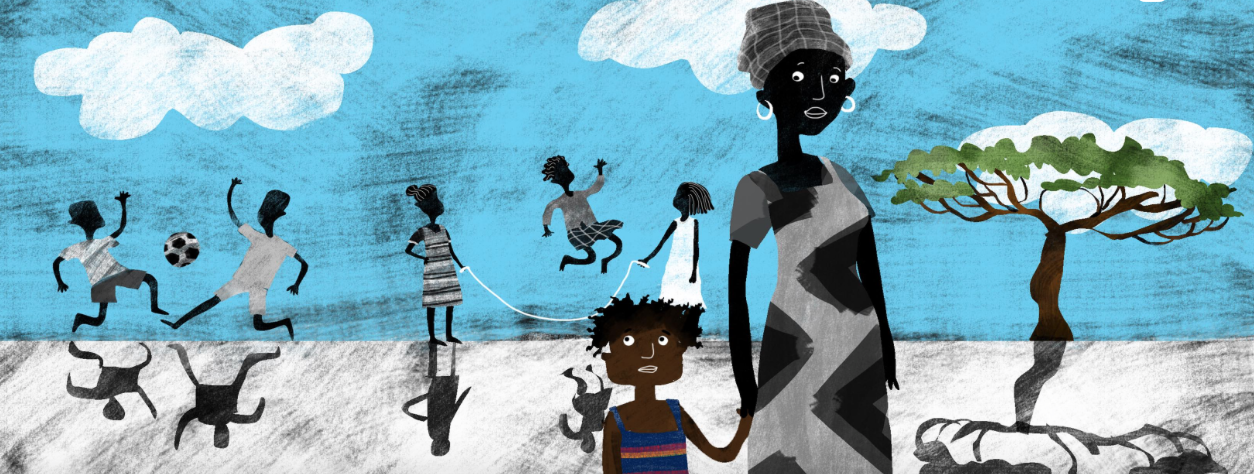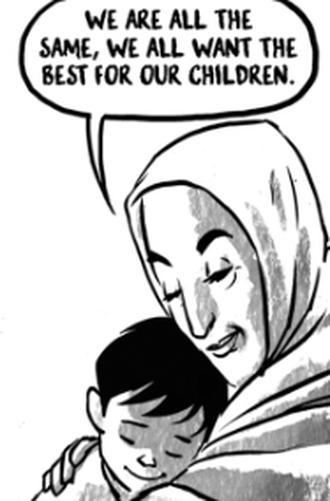Benjamin Dix on Art, using Comics to help people have a Voice, founding Positive Negatives, Humanity and People as One
Benjamin Dix's passion for giving a voice to people is seen through the work he and the Positive Negatives team do. His passion for justice for humanity and changing the world is also felt through his own voice, he speaks from the heart about his journey and Positive Negatives...
What I try and avoid is the religious and the political perspectives. I mean obviously most of the comics have got a political perspective in themselves and as they are human stories, all the people we are talking about have their own perspective, but it’s not what I’m trying to do, I’m just trying to convey human experiences and stories; that to me is the more interesting element. Other people write about politics, and they write about religion, but I’m interested in the core of human stories. Whether it’s Hasko, Mohammad or Khalid, they are three completely different people but they’ve all had to leave their homes in Syria. Whether or not they were happy or unhappy before the revolution, they are now in Europe and they are not at home. That’s the story I’ve always tried to tell whether it’s theirs or anyone else’s.
Just to go back to the beginning, how and why did you start Positive Negatives?
I've had the name Positive Negatives since the year 1999 or 2000. I was a photographer then, I did my first exhibition at SOAS in the Brunei Gallery in 2000 on the Maha Kumbh Mela, which is a big Indian Hindu festival. I think it’s the biggest pilgrimage in the world and it happens once every three years in four different places around India. During that time, I was talking to my dad saying that actually I should do this as a company and I questioned what it should be called and we sat down over a glass of wine and came up with the name Positive Negatives, which worked for photography. So really then I was looking at it in terms of the negative of photography turning into a positive in the dark room, especially back then, this was pre digital so it was 35 mm negatives.
I later worked with the UN and the NGO’s in Sri Lanka, so to answer your question, in the conflict in Sri Lanka I was the liaison officer between the United Nations and the Tamil Tigers and from 2007, until the evacuation in September 2008, we spent a lot of time in the bunker just under air attack and artillery attack. Day by day we spent hours and hours in the bunker and it became what was normal. I started watching HBO box sets: I watched all of ‘The Wire’ in the bunker, because there’s nothing to do- what else is there to do except sit in a bunker?
You know the first few times you run to the bunker on air attack it’s scary, the hundredth time you’ve done it, it’s just another day. One day, a colleague handed me a copy of ‘Maus’ Art Spiegelman’s novel on the Holocaust. I’d never read anything like that before, in terms of comics I’d read some Tintin, Calvin and Hobbs, some Beano and then suddenly I was reading this absolutely fascinating, super engaging, visual story on the Holocaust, where Art Spiegelman has interviewed his father about his memories of surviving Auschwitz, depicting the Jews as mice and the Nazis as cats. It dealt a lot with the father’s reflection on memories of the Holocaust and I just found that the illustrated form was able to take me, the reader, into all these different spaces of memory, trauma, reflection, dreams, future, ambition, all of these spaces that are really difficult to do in the written form. Yes you can write about it, and we can use our imagination, but the author of the graphic novel can direct me into these spaces and really show me stuff. I read that comic cover-to-cover that day. I was in the bunker for a few hours and I came out that evening, looked around, and there were the Sri Lankan Air force flying around, us the UN, there were the Tamil Tiger rebels, the Sri Lankan Tamil civilians who were internally displaced, and I thought, this here is a graphic novel, and so I kind of then just had this idea of creating a graphic novel about Sri Lanka.
Three or four years later, I finished my Master’s degree, and many of my Sri Lankan colleagues who’d survived the conflict were seekering asylum in London and Zurich, and refugees in Chennai, so I started to go and see them and I felt incredibly…well I was devastated with the failings and the inactions of the UN and my own sense of abandonment. I think I always understood it in a wider political spectrum of the evacuation, I didn’t agree with it, but I understood it: the mechanisms of the way the planet works. I’m not naïve, I get it, but on a personal level, I was still an individual that had got out, got in a car, hugged my friends goodbye that I’d known for four years and left them to their fate, and that messed me up on a quite profound level. It had brought about a complete shift of who I am, who I was in the world and what I do in my life.
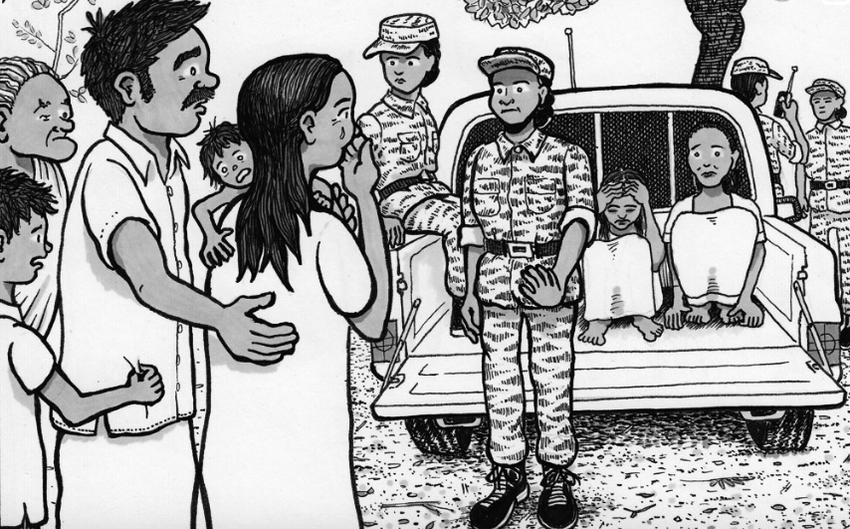

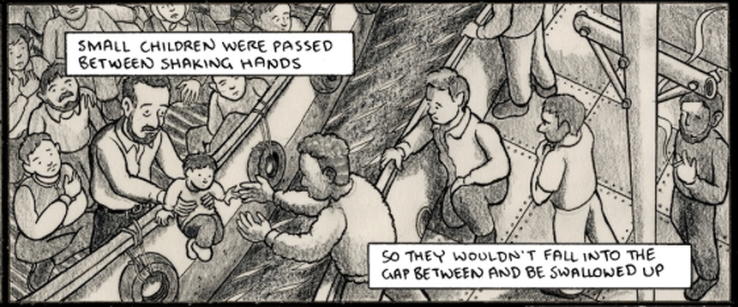

I've had the name Positive Negatives since the year 1999 or 2000. I was a photographer then, I did my first exhibition at SOAS in the Brunei Gallery in 2000 on the Maha Kumbh Mela, which is a big Indian Hindu festival. I think it’s the biggest pilgrimage in the world and it happens once every three years in four different places around India. During that time, I was talking to my dad saying that actually I should do this as a company and I questioned what it should be called and we sat down over a glass of wine and came up with the name Positive Negatives, which worked for photography. So really then I was looking at it in terms of the negative of photography turning into a positive in the dark room, especially back then, this was pre digital so it was 35 mm negatives.
I later worked with the UN and the NGO’s in Sri Lanka, so to answer your question, in the conflict in Sri Lanka I was the liaison officer between the United Nations and the Tamil Tigers and from 2007, until the evacuation in September 2008, we spent a lot of time in the bunker just under air attack and artillery attack. Day by day we spent hours and hours in the bunker and it became what was normal. I started watching HBO box sets: I watched all of ‘The Wire’ in the bunker, because there’s nothing to do- what else is there to do except sit in a bunker?
You know the first few times you run to the bunker on air attack it’s scary, the hundredth time you’ve done it, it’s just another day. One day, a colleague handed me a copy of ‘Maus’ Art Spiegelman’s novel on the Holocaust. I’d never read anything like that before, in terms of comics I’d read some Tintin, Calvin and Hobbs, some Beano and then suddenly I was reading this absolutely fascinating, super engaging, visual story on the Holocaust, where Art Spiegelman has interviewed his father about his memories of surviving Auschwitz, depicting the Jews as mice and the Nazis as cats. It dealt a lot with the father’s reflection on memories of the Holocaust and I just found that the illustrated form was able to take me, the reader, into all these different spaces of memory, trauma, reflection, dreams, future, ambition, all of these spaces that are really difficult to do in the written form. Yes you can write about it, and we can use our imagination, but the author of the graphic novel can direct me into these spaces and really show me stuff. I read that comic cover-to-cover that day. I was in the bunker for a few hours and I came out that evening, looked around, and there were the Sri Lankan Air force flying around, us the UN, there were the Tamil Tiger rebels, the Sri Lankan Tamil civilians who were internally displaced, and I thought, this here is a graphic novel, and so I kind of then just had this idea of creating a graphic novel about Sri Lanka.
Three or four years later, I finished my Master’s degree, and many of my Sri Lankan colleagues who’d survived the conflict were seekering asylum in London and Zurich, and refugees in Chennai, so I started to go and see them and I felt incredibly…well I was devastated with the failings and the inactions of the UN and my own sense of abandonment. I think I always understood it in a wider political spectrum of the evacuation, I didn’t agree with it, but I understood it: the mechanisms of the way the planet works. I’m not naïve, I get it, but on a personal level, I was still an individual that had got out, got in a car, hugged my friends goodbye that I’d known for four years and left them to their fate, and that messed me up on a quite profound level. It had brought about a complete shift of who I am, who I was in the world and what I do in my life.
So as I was meeting old friends that had survived in Chennai, Zurich and London, I thought, actually this is the graphic novel I’m going to write, their story of surviving the war. That idea then turned into my PhD in visual anthropology, in that, transformation of complex, trauma and migration into sequential art. Then in the second year of my PhD, I thought, let’s set this up as an organisation, to do exactly this, to give people a voice, through art. The thing with the Sri Lankan Tamils is that they were coming out of Sri Lanka as survivors at the same time as Tunisia, Libya and Egypt were kicking off with the so called “Arab Spring” which was getting massive media attention, but no one was talking about Sri Lanka. An estimate of 40,000 to 150,000 people died in Sri Lanka, that’s a massive death toll, and so I thought what I’m creating here is a really important tool to express individual stories: I don’t want it to express people’s political voice, I don’t want it to be a religious voice, I don’t really want it to be like advocacy, I just wanted it to be a space where individuals, who don’t have a global voice, in them being trafficked or having gone through sexual violence or any other circumstance, for them to be able to tell it in an engaging way through art. So I was thinking, what do you call such an organisation, well this is Positive Negatives, this is actually the proper incarnation of it: it’s about tackling negative issues and creating positive and empathetic ones out of them. So I started Positive Negatives.

Image from "The Vanni" comic funded by the Arts Council England. Positive Negatives are currently developing a graphic novel, The Vanni, focusing on the Sri Lankan conflict between the Sri Lankan Government and the Liberation Tigers of Tamil Eelam (LTTE). The Vanni forms the basis of Benjamin Dix's PhD in the transformation of complex testimony into comic books and has been meticulously researched over the past 4 years. Illustration by Lindsay Pollock
What you started with photography led you, your journey, to Positive Negatives,
Yes absolutely, and also through academia and journalism, general storytelling. Through my career, I’ve mostly been in some form of communications, whether it’s photo journalism or other parts of my career with the UN. I have gone through the academic spectrum, but I've never seen myself as an academic: I like writing in a way that non-academics can understand. I wanted to write something that people could understand and read. And so all of those career paths have really now led to what I do with comics, which is to tell human stories, visually and it’s wonderful now to be surrounded by a background of journalism, photography, art, academia, research, UN, all of these things I put into Positive Negatives, into the comics.
Yes absolutely, and also through academia and journalism, general storytelling. Through my career, I’ve mostly been in some form of communications, whether it’s photo journalism or other parts of my career with the UN. I have gone through the academic spectrum, but I've never seen myself as an academic: I like writing in a way that non-academics can understand. I wanted to write something that people could understand and read. And so all of those career paths have really now led to what I do with comics, which is to tell human stories, visually and it’s wonderful now to be surrounded by a background of journalism, photography, art, academia, research, UN, all of these things I put into Positive Negatives, into the comics.
There is so much emotion in the actual drawing lines of the comics, do you choose the illustrator according to the story or vice versa? Or does it happen almost naturally, because the illustrations do change depending on the story you are conveying.
We now have a database of nearly 100 artists, illustrators and animators around the world, but we have a core group of 5 who are Lindsay Pollock, Gabi Froden, Asia Alfasi, Rob Davis and Karrie Fransman. We are going to be working with more and more artists, and on current projects and fieldtrips, I’ve been spending a couple of days on every trip and meeting new artists so we can work with local artists. What is quite difficult is that you find lots of amazing artists in the world, but comic book art is quite a specific type of art and so in Sri Lanka I’ve just met some amazing conceptual artists, illustrators and painters but they don’t do sequential art. Certainly if it’s a female led story we work with female artists and the only two we haven’t done, was when Rob drew Nadia’s story and the other one is when Positive Negatives was just Lindsay and I, and we didn’t have any other artists, so Lindsay drew the story of Almaz.
Almaz’s story is a very powerful and heartbreaking one
Yeah it is and Lindsay did amazingly well depicting it. I don’t think there’s any issue there, but when we did that, going through that, both of us were a little uncomfortable, this was a female led story interviewed, illustrated and written by two guys, and we said let’s change this next time. So since then, all female led stories have been researched, illustrated and written by either Asia, Gabi or Karrie. That’s something that we are quite clear about now.
We now have a database of nearly 100 artists, illustrators and animators around the world, but we have a core group of 5 who are Lindsay Pollock, Gabi Froden, Asia Alfasi, Rob Davis and Karrie Fransman. We are going to be working with more and more artists, and on current projects and fieldtrips, I’ve been spending a couple of days on every trip and meeting new artists so we can work with local artists. What is quite difficult is that you find lots of amazing artists in the world, but comic book art is quite a specific type of art and so in Sri Lanka I’ve just met some amazing conceptual artists, illustrators and painters but they don’t do sequential art. Certainly if it’s a female led story we work with female artists and the only two we haven’t done, was when Rob drew Nadia’s story and the other one is when Positive Negatives was just Lindsay and I, and we didn’t have any other artists, so Lindsay drew the story of Almaz.
Almaz’s story is a very powerful and heartbreaking one
Yeah it is and Lindsay did amazingly well depicting it. I don’t think there’s any issue there, but when we did that, going through that, both of us were a little uncomfortable, this was a female led story interviewed, illustrated and written by two guys, and we said let’s change this next time. So since then, all female led stories have been researched, illustrated and written by either Asia, Gabi or Karrie. That’s something that we are quite clear about now.
When I was looking through the illustrations, I was reading the words of course, but the images were speaking on their own. The emotion that goes into the drawings I can imagine either you spend a lot of time with the illustrator or the illustrator spends a lot of time with the person who is giving the testimony, because the lines of the drawings are very heartfelt, it’s more than just passing on a story, we can feel the story too
I am pleased you felt that. All the illustrators we have worked with, are really smart, they are documentary makers but in an illustrative form. They are storytellers, they are sensitive and they really ‘feel’ the stories. Like Gabi Froden for example, she drew the Abike story, about a Nigerian woman being trafficked, and she went through hell drawing that story. For hours everyday she was drawing Abike locked in a basement being raped, and for Gabi to do that took a lot. I remember Gabi telling me that she couldn’t meet up with her mates at that time, because she was locked in a basement with Abike’s story and she poured that emotion into the illustration of it.
All of the illustrators have felt an emotional bond to the story they are depicting, like Lindsay Pollock- his drawings in the Sri Lankan book, he has illustrated about 280 pages of it over the last 4 years, through him just absorbing himself with images of Sri Lanka and we went to South India together so he could understand what the environment looked like.
Why were you banned from Sri Lanka, because of what you were doing?
Because I was in the Tamil Tiger area for 4 years and when I got out and did 2 documentaries with Chanel 4 called Sri Lanka’s Killing Fields and No Fire Zone where I am on them speaking out critically about the failings of the UN and about the Sri Lankan government and basically the documentary accused the Sri Lankan State of War Crimes, and the government didn’t seem to like that!
I am pleased you felt that. All the illustrators we have worked with, are really smart, they are documentary makers but in an illustrative form. They are storytellers, they are sensitive and they really ‘feel’ the stories. Like Gabi Froden for example, she drew the Abike story, about a Nigerian woman being trafficked, and she went through hell drawing that story. For hours everyday she was drawing Abike locked in a basement being raped, and for Gabi to do that took a lot. I remember Gabi telling me that she couldn’t meet up with her mates at that time, because she was locked in a basement with Abike’s story and she poured that emotion into the illustration of it.
All of the illustrators have felt an emotional bond to the story they are depicting, like Lindsay Pollock- his drawings in the Sri Lankan book, he has illustrated about 280 pages of it over the last 4 years, through him just absorbing himself with images of Sri Lanka and we went to South India together so he could understand what the environment looked like.
Why were you banned from Sri Lanka, because of what you were doing?
Because I was in the Tamil Tiger area for 4 years and when I got out and did 2 documentaries with Chanel 4 called Sri Lanka’s Killing Fields and No Fire Zone where I am on them speaking out critically about the failings of the UN and about the Sri Lankan government and basically the documentary accused the Sri Lankan State of War Crimes, and the government didn’t seem to like that!
We take for granted freedom of expression, and as I was reading the comics, like A Perilous Journey, the trilogy from Syria, where that’s clearly been an issue, I wondered if the stories were from anonymous testimonies
Hasko is Hasko, he’s a very famous Syrian artist, a painter, you Google him, you will find his paintings selling for something like $20,000 in galleries in New York. What was very interesting about the trilogy was that we weren’t showing just one sphere of class. For instance, Mohammad in that trilogy was a labourer and he had to make that journey, whereas Hasko is a relatively wealthy, internationally renowned artist, who found himself on a boat going across the Mediterranean. The middle class audience of Europe could suddenly relate to this guy who had been living in Syria with en suite bathrooms, went out partying with his wife at the weekend, drank, and had a ‘westernised’ lifestyle but was then on a trafficker’s boat going across the Mediterranean.
Hasko is Hasko, he’s a very famous Syrian artist, a painter, you Google him, you will find his paintings selling for something like $20,000 in galleries in New York. What was very interesting about the trilogy was that we weren’t showing just one sphere of class. For instance, Mohammad in that trilogy was a labourer and he had to make that journey, whereas Hasko is a relatively wealthy, internationally renowned artist, who found himself on a boat going across the Mediterranean. The middle class audience of Europe could suddenly relate to this guy who had been living in Syria with en suite bathrooms, went out partying with his wife at the weekend, drank, and had a ‘westernised’ lifestyle but was then on a trafficker’s boat going across the Mediterranean.

'A Perilous Journey' is a trilogy of comics based on testimonies taken from Syrian refugees seeking asylum in Scandinavia in July 2015. The comics were serialised in The Guardian and Aftenposten (11-13 Nov 2015) and an exhibition launched at the Nobel Peace Centre, Oslo (12 Nov 2015). The project was generously funded by Norwegian People's Aid. Illustration by Lindsay Pollock. Animation by Wael Toubaji.
Most if not all of the class spectrum in that trilogy of Syrian stories is represented
It's not about if someone is Allawite, Shia, Christian or whatever they are, it’s a family - it's about families and people.
A human perspective
I am not here to judge on people’s politics, what do I know, I’m not Syrian; But a family who is making that journey, leaving as when Hasko left his wife and their three children in Turkey where he started his journey and where he didn’t know if he was going to make it or not, he didn’t know if he was going to be given asylum in Denmark, he didn’t know if he was going to see his wife and kids again, he didn’t know about the security of his wife and kids left in Turkey. All of that narrative you want to bring into the story, into the illustrations, because suddenly all these dads in the UK, whether you’re a Guardian reader or a Daily Mail reader, you would be able to relate to that. That’s what is important, and so to be able to show the different class structure of Mohammad the labourer, Khalid the student and Hasko the world renowned artist, just shows you that war affects everyone and cuts trough all of these strata of class and wealth, and our security and perceived security.
It's not about if someone is Allawite, Shia, Christian or whatever they are, it’s a family - it's about families and people.
A human perspective
I am not here to judge on people’s politics, what do I know, I’m not Syrian; But a family who is making that journey, leaving as when Hasko left his wife and their three children in Turkey where he started his journey and where he didn’t know if he was going to make it or not, he didn’t know if he was going to be given asylum in Denmark, he didn’t know if he was going to see his wife and kids again, he didn’t know about the security of his wife and kids left in Turkey. All of that narrative you want to bring into the story, into the illustrations, because suddenly all these dads in the UK, whether you’re a Guardian reader or a Daily Mail reader, you would be able to relate to that. That’s what is important, and so to be able to show the different class structure of Mohammad the labourer, Khalid the student and Hasko the world renowned artist, just shows you that war affects everyone and cuts trough all of these strata of class and wealth, and our security and perceived security.

Hasko's story illustrated by Lindsay Pollock
Khalid's story illustrated by Lindsay Pollock
I think you’ve really achieved representing many different voices, because as I was reading one of the illustrations from the Syrian trilogy, when one of them voiced a more political opinion, at first I thought, that’s the perspective of the person’s testimony, there will be other opinions, but then I read the other’s and it was clear how almost everyone’s perspective who had to make that journey is represented.
Everything I am doing, the foundation of this, is the evacuation from Sri Lanka. That completely changed my perspective on my own privilege, where it was the white man who was evacuated and the brown Tamil man who stayed behind in the conflict, where they went through horrible experiences or perished. What I found was that there is a real distinction when you are working in the field with the UN, between that of the expats and the locals and I’ve never been like that. I had lived in India before my time in Sri Lanka, and when I lived in India my friends were Indian and when I lived in Sri Lanka my friends were Sri Lankan. Of course I had expat friends, but you don’t go to live on the other side of the world to hang out with people who are like you: you immerse yourself and you get to see that you are all the same. Like one of my friends in Sri Lanka was my project officer Antoni, a Sri Lankan Tamil, for four years we would travel around together and I introduced him to the music of Nina Simone and Bob Marley, he taught me how to ride a motorbike and we went on holiday together in Lao. We rode around Lao together, it’s a genuine friendship; so you make those friends and then you have to leave and evacuate and they are left to their own defense, which is without anything.
When you read in a newspaper that there’s a train crash and 300 hundred people died, well that’s 300 people that aren’t coming home that evening, 300 husbands, wives, children, and then the trauma that runs through that family. Whether your job is in construction or you are a top banker, you are a human being and all of the projects that we do, is exactly that, we are all different, we have different religions, we have different aspirations, we have different humour, we dress differently, but we are all fundamentally the same. Like many people, I am getting tiered of the media isolating us, and putting the “us” and “them” forward, because there is no "us" and "them". You are Lebanese and I’m English and we’re the same and what I’m finding is that the comics are a real powerful tool to just present Hasko, as a dad and a husband, he’s trying to earn a living and then suddenly he has to get on a boat and go across the Mediterranean sea, he’s messed up, he’s scared, he’s sad, he’s terrified, he’s lonely. And there’s Mohammad, he’s a labourer, he’s trying to get money to go to Iraq to be a labourer, and he has to run, but that in turn ended up as an adventure for him, because he’s never been outside the Middle East: he was sleeping in a tent in the fields of Bulgaria and he was like ‘wow the world is big’; the sunrise over the rolling fields of Europe look totally different to Syria and Iraq. There’s a bit of an adventure to it, which doesn’t take away any of the trauma, but there is that aspect that is felt.
Everything I am doing, the foundation of this, is the evacuation from Sri Lanka. That completely changed my perspective on my own privilege, where it was the white man who was evacuated and the brown Tamil man who stayed behind in the conflict, where they went through horrible experiences or perished. What I found was that there is a real distinction when you are working in the field with the UN, between that of the expats and the locals and I’ve never been like that. I had lived in India before my time in Sri Lanka, and when I lived in India my friends were Indian and when I lived in Sri Lanka my friends were Sri Lankan. Of course I had expat friends, but you don’t go to live on the other side of the world to hang out with people who are like you: you immerse yourself and you get to see that you are all the same. Like one of my friends in Sri Lanka was my project officer Antoni, a Sri Lankan Tamil, for four years we would travel around together and I introduced him to the music of Nina Simone and Bob Marley, he taught me how to ride a motorbike and we went on holiday together in Lao. We rode around Lao together, it’s a genuine friendship; so you make those friends and then you have to leave and evacuate and they are left to their own defense, which is without anything.
When you read in a newspaper that there’s a train crash and 300 hundred people died, well that’s 300 people that aren’t coming home that evening, 300 husbands, wives, children, and then the trauma that runs through that family. Whether your job is in construction or you are a top banker, you are a human being and all of the projects that we do, is exactly that, we are all different, we have different religions, we have different aspirations, we have different humour, we dress differently, but we are all fundamentally the same. Like many people, I am getting tiered of the media isolating us, and putting the “us” and “them” forward, because there is no "us" and "them". You are Lebanese and I’m English and we’re the same and what I’m finding is that the comics are a real powerful tool to just present Hasko, as a dad and a husband, he’s trying to earn a living and then suddenly he has to get on a boat and go across the Mediterranean sea, he’s messed up, he’s scared, he’s sad, he’s terrified, he’s lonely. And there’s Mohammad, he’s a labourer, he’s trying to get money to go to Iraq to be a labourer, and he has to run, but that in turn ended up as an adventure for him, because he’s never been outside the Middle East: he was sleeping in a tent in the fields of Bulgaria and he was like ‘wow the world is big’; the sunrise over the rolling fields of Europe look totally different to Syria and Iraq. There’s a bit of an adventure to it, which doesn’t take away any of the trauma, but there is that aspect that is felt.

Mohammad's story illustrated by Lindsay Pollock
There is a lot of detail in the stories, in each comic square, we feel like we are there with the person. As I was reading them I was thinking of asking you, how much power do you think comics and art have and can they make an impact?
And also in relation to the feeling of shame, that in the century that we are in, there are still these issues, like you said life is unfair and in part may always be, but I guess there is sometimes shaming used in politics, can you shame countries into changing their ways or laws? I did feel that these testimonies could bring out a sense of shame that these are all happening in our world
It’s really important to tell Abike’s story and to position it where it was, which is here in London.
Like this was in a basement here in London, on a street just like this one we are on, if not more of a residential street, but you know this stuff happens, this isn’t happening on the other side of the world, it’s happening here in London. What I wanted to show with that was that once again, this isn’t “us” and “them”, this is us, and we have a responsibility to do something. Where is our responsibility to look out for this stuff, where is our responsibility to look out for the girl on the bus who doesn’t look comfortable sitting next to that guy, and do we act all British about it and not say anything or do we actually confront it and say something?
You know there are people at the moment trapped in this city in a basement and the police don’t go looking for them, because it isn’t about guns and drugs, and there aren’t the resources available to look for the Abikes of the city and when women like Abike do try and escape then they get picked up and prosecuted for being illegal immigrants. It’s all just topsy-turvy, the girls become the criminals and then they don’t go looking for the traffickers because they haven’t got the resources and there are only so many resources they are going to put into that, so in a sense that’s a kind of shaming of what kind of society we live in.
But I also just think the comics and stories we write are to show people that people are all the same fundamentally. I spend my life travelling the world, it’s an incredibly privileged life of meeting interesting people. I was going to say wonderful instead of interesting, but they are not all wonderful- I’ve met some right idiots, like any human could be, it’s human, right? I was running round Eastern Europe interviewing refugees and you know sometimes I would read things like they are all extraordinary people, but you know they are not, they are just people, and you meet some extraordinary people and you meet some that are not. Like everywhere, you meet some ridiculously smart people out there and then some real duffers! I met a few refugees who were not particularly nice people and it’s so refreshing because you think, ah, I really like you because you don’t fit that mold of being this extraordinary person – so you know – I really enjoy that, because it brings it back down, to just humans – and we are funny and quirky.
That’s what I like about Gabi’s drawings, she did Abike and our new comic Born Julia and Julius, she draws people a bit skewed.
And also in relation to the feeling of shame, that in the century that we are in, there are still these issues, like you said life is unfair and in part may always be, but I guess there is sometimes shaming used in politics, can you shame countries into changing their ways or laws? I did feel that these testimonies could bring out a sense of shame that these are all happening in our world
It’s really important to tell Abike’s story and to position it where it was, which is here in London.
Like this was in a basement here in London, on a street just like this one we are on, if not more of a residential street, but you know this stuff happens, this isn’t happening on the other side of the world, it’s happening here in London. What I wanted to show with that was that once again, this isn’t “us” and “them”, this is us, and we have a responsibility to do something. Where is our responsibility to look out for this stuff, where is our responsibility to look out for the girl on the bus who doesn’t look comfortable sitting next to that guy, and do we act all British about it and not say anything or do we actually confront it and say something?
You know there are people at the moment trapped in this city in a basement and the police don’t go looking for them, because it isn’t about guns and drugs, and there aren’t the resources available to look for the Abikes of the city and when women like Abike do try and escape then they get picked up and prosecuted for being illegal immigrants. It’s all just topsy-turvy, the girls become the criminals and then they don’t go looking for the traffickers because they haven’t got the resources and there are only so many resources they are going to put into that, so in a sense that’s a kind of shaming of what kind of society we live in.
But I also just think the comics and stories we write are to show people that people are all the same fundamentally. I spend my life travelling the world, it’s an incredibly privileged life of meeting interesting people. I was going to say wonderful instead of interesting, but they are not all wonderful- I’ve met some right idiots, like any human could be, it’s human, right? I was running round Eastern Europe interviewing refugees and you know sometimes I would read things like they are all extraordinary people, but you know they are not, they are just people, and you meet some extraordinary people and you meet some that are not. Like everywhere, you meet some ridiculously smart people out there and then some real duffers! I met a few refugees who were not particularly nice people and it’s so refreshing because you think, ah, I really like you because you don’t fit that mold of being this extraordinary person – so you know – I really enjoy that, because it brings it back down, to just humans – and we are funny and quirky.
That’s what I like about Gabi’s drawings, she did Abike and our new comic Born Julia and Julius, she draws people a bit skewed.
In Abike’s illustration when she is running, one of her arms is slightly higher than the other
Yes and Julia’s got one ear bigger than the other
It makes it real
Yeah because we are all a little bit like that in reality, none of us are perfect, you know I love the way she brings that out in her artwork, and I also love how Lindsay draws very realistically, like you can see Hasko, and you can almost recognize Hasko from the drawings whereas with Gabi’s you wouldn’t recognize Julia from the drawings.
Yes and Julia’s got one ear bigger than the other
It makes it real
Yeah because we are all a little bit like that in reality, none of us are perfect, you know I love the way she brings that out in her artwork, and I also love how Lindsay draws very realistically, like you can see Hasko, and you can almost recognize Hasko from the drawings whereas with Gabi’s you wouldn’t recognize Julia from the drawings.
In Abike’s story, the square where she is talking to her trafficker Mary, is so vital, because Mary doesn’t seem scary at first, and I immediately linked that up to your charity Why comics? that you are going to teach this to kids, that someone like “Mary”, can at the beginning be so trusting and caring and then change, and she is of a certain age as well
Yeah she’s an aunty
She’s an aunty, she’s not some scary person or creepy guy, I wondered if as well as creating empathy and respect for people’s perspectives and stories, that these comics are also a tool to teach about life
Yes and also to break down stereotypes, usually traffickers are portrayed as the bogey man, the bearded bloke, the dodgy guy and all of that, it often is, but it also is quite often someone like Mary. She’s a great trafficker, because if a 30 year old guy had gone and confronted Abike in the coffee shop in Lagos, then Abike would have probably been quite distrusting of him, she’s a smart woman; but the 50 year old British Nigerian woman with her words of "tell me your story child", then of course she appears to be trusting. You are not going to look at her as a trafficker, she couldn’t possibly take you to London and lock you up, but for £400 an hour, you are a commodity to her.
So, you know, Abike’s story is a testimony, we didn’t make up Abike, Mary exists, and she’s still at large, the police didn’t go after Mary. No they don’t go after Mary, because Abike didn’t give them anything. So they got Abike and they treated her as an illegal immigrant, and when they realised she’d been trafficked, well, she doesn’t know London, she just got out of that house and ran, she doesn’t know the house, where it is, who’s house it is, or even if the woman’s real name is Mary, and so the police are not going to put in a lot of effort to look for a Nigerian woman.
Yeah she’s an aunty
She’s an aunty, she’s not some scary person or creepy guy, I wondered if as well as creating empathy and respect for people’s perspectives and stories, that these comics are also a tool to teach about life
Yes and also to break down stereotypes, usually traffickers are portrayed as the bogey man, the bearded bloke, the dodgy guy and all of that, it often is, but it also is quite often someone like Mary. She’s a great trafficker, because if a 30 year old guy had gone and confronted Abike in the coffee shop in Lagos, then Abike would have probably been quite distrusting of him, she’s a smart woman; but the 50 year old British Nigerian woman with her words of "tell me your story child", then of course she appears to be trusting. You are not going to look at her as a trafficker, she couldn’t possibly take you to London and lock you up, but for £400 an hour, you are a commodity to her.
So, you know, Abike’s story is a testimony, we didn’t make up Abike, Mary exists, and she’s still at large, the police didn’t go after Mary. No they don’t go after Mary, because Abike didn’t give them anything. So they got Abike and they treated her as an illegal immigrant, and when they realised she’d been trafficked, well, she doesn’t know London, she just got out of that house and ran, she doesn’t know the house, where it is, who’s house it is, or even if the woman’s real name is Mary, and so the police are not going to put in a lot of effort to look for a Nigerian woman.
Do you think the impact of these comics could be to make the push for change?
The Abike story went through to parliament, a part of the Modern Slavery Act. That was for me, one of the most powerful projects that we've worked on. In 2015, we worked with the Guardian and the Poppy Project, and the Poppy Project were the lawyers for Abike. The legislation goes through parliament and so we visualised the legislation by doing the Abike project and that helped MPs to see modern day slavery, not just read pages and pages of dry legal legislation, but see a woman, a girl growing up in Nigeria and then being locked-up in a basement and raped on a daily basis and then being locked up by the state and being punished for being illegally in the country, and that had a major impact on how people saw modern day slavery, because people saw it: they are not just reading about it, they are seeing it at the same time.
The Abike story went through to parliament, a part of the Modern Slavery Act. That was for me, one of the most powerful projects that we've worked on. In 2015, we worked with the Guardian and the Poppy Project, and the Poppy Project were the lawyers for Abike. The legislation goes through parliament and so we visualised the legislation by doing the Abike project and that helped MPs to see modern day slavery, not just read pages and pages of dry legal legislation, but see a woman, a girl growing up in Nigeria and then being locked-up in a basement and raped on a daily basis and then being locked up by the state and being punished for being illegally in the country, and that had a major impact on how people saw modern day slavery, because people saw it: they are not just reading about it, they are seeing it at the same time.
Each comic has a particular visual too
Yes, so for the comic Born Julia and Julius, I really wanted Gabi to do that one, because Julius is intersex, so it’s a story about us not being perfect, it’s a story about being born with both genitalia and not being this model of what we think the human is.
Julius is a defender of the right of intersex people, but he’s just a normal chap.
There’s a lot of empathy in the style of illustration that goes with that testimony
Yes I love the way she has drawn it, it’s bright and positive.
Yes, so for the comic Born Julia and Julius, I really wanted Gabi to do that one, because Julius is intersex, so it’s a story about us not being perfect, it’s a story about being born with both genitalia and not being this model of what we think the human is.
Julius is a defender of the right of intersex people, but he’s just a normal chap.
There’s a lot of empathy in the style of illustration that goes with that testimony
Yes I love the way she has drawn it, it’s bright and positive.
What happens to the stories that are not commissioned, do you try to do them as comics?
That’s growing at the moment. I started all of this with the Sri Lankan project and hopefully the graphic novel of that will be finished by the end of the year. I mean, that initial project had taken such a life on its own, I then started Positive Negatives and to build up an organisation, you have to take commissions and luckily I’ve attracted commissions, and it’s been the right commissioners, such as the Norwegian People’s Aid, the Guardian, CARE International, etc. So it’s the people I wanted to work for and the stories I wanted to do, and now, only really now I guess I’m at a point with the organisation where we have enough of a track history to go out and fish for our own work, that’s great but it’s a lot of proposal writing!
I would like to show the story of an elephant tusk taken from South Africa to China and the innocence of that elephant, this huge beast that is caught up in that trafficking world and all it wants to do is live, that’s all an elephant wants to do and yet it’s being hunted. What I am getting into now is a lot of augmented reality and what I also really want to do is with a graffiti artist, who does amazing murals, have just an elephant painted on a big wall, but when you hold your phone up to it, out of the phone comes up how many elephants have been trafficked, how many tones of ivory; all this information of trafficking but it doesn’t take anything away from the beauty of the mural, but we use the augmented reality to educate and to create advocacy. All that work, we are getting into with AR and to bring in education without upsetting the integrity of the art.
That’s growing at the moment. I started all of this with the Sri Lankan project and hopefully the graphic novel of that will be finished by the end of the year. I mean, that initial project had taken such a life on its own, I then started Positive Negatives and to build up an organisation, you have to take commissions and luckily I’ve attracted commissions, and it’s been the right commissioners, such as the Norwegian People’s Aid, the Guardian, CARE International, etc. So it’s the people I wanted to work for and the stories I wanted to do, and now, only really now I guess I’m at a point with the organisation where we have enough of a track history to go out and fish for our own work, that’s great but it’s a lot of proposal writing!
I would like to show the story of an elephant tusk taken from South Africa to China and the innocence of that elephant, this huge beast that is caught up in that trafficking world and all it wants to do is live, that’s all an elephant wants to do and yet it’s being hunted. What I am getting into now is a lot of augmented reality and what I also really want to do is with a graffiti artist, who does amazing murals, have just an elephant painted on a big wall, but when you hold your phone up to it, out of the phone comes up how many elephants have been trafficked, how many tones of ivory; all this information of trafficking but it doesn’t take anything away from the beauty of the mural, but we use the augmented reality to educate and to create advocacy. All that work, we are getting into with AR and to bring in education without upsetting the integrity of the art.
That's great because I suppose using more and more technology to educate will all be part of the future.
Is the charity Why Comics? a part of Positive Negatives or is it a separate element?
It’s part of it and it’s separate. Positive Negatives is a non-for-profit research and production organisation and Why Comics? is a registered charity. They are separate, but Why Comics? exists because of Positive Negatives and so the way it works is that Positive Negatives get commissioned or funded to produce projects, we do all the research and the production in Positive Negatives, we commission the researchers and artists to do the field work, we produce the work, we then give it to the media and the media put it out to thousands or millions of viewers, and then we, Positive Negatives, donate that animation or that comic to Why Comics? the charity, which is based at SOAS. The charity then has researchers working at SOAS, who do all of the links behind the pages of the comic and then disseminate it out for free as educational tools to schools all around the world. The donor who originally pays for it all, commissioned it for Positive Negatives they then have their logo on it, such as, this comic comes to you from Care International for instance, and it's then delivered to schools all over the world. So everyone is kind of happy the media have free content, the commissioner gets their comic out into the media and then they get it into schools to teach the next generations for years to come and it’s a really nice kind of circle.
Is the charity Why Comics? a part of Positive Negatives or is it a separate element?
It’s part of it and it’s separate. Positive Negatives is a non-for-profit research and production organisation and Why Comics? is a registered charity. They are separate, but Why Comics? exists because of Positive Negatives and so the way it works is that Positive Negatives get commissioned or funded to produce projects, we do all the research and the production in Positive Negatives, we commission the researchers and artists to do the field work, we produce the work, we then give it to the media and the media put it out to thousands or millions of viewers, and then we, Positive Negatives, donate that animation or that comic to Why Comics? the charity, which is based at SOAS. The charity then has researchers working at SOAS, who do all of the links behind the pages of the comic and then disseminate it out for free as educational tools to schools all around the world. The donor who originally pays for it all, commissioned it for Positive Negatives they then have their logo on it, such as, this comic comes to you from Care International for instance, and it's then delivered to schools all over the world. So everyone is kind of happy the media have free content, the commissioner gets their comic out into the media and then they get it into schools to teach the next generations for years to come and it’s a really nice kind of circle.
Do you sometimes go back to see people that have given testimonies?
Yes sometimes, if I go back to a country, I always go out of my way to go back to see people but I don’t have the time or the budget to take a specific flight to Addis Ababa to visit Almaz. If I am there, I will visit her.
I stay in touch as much as possible, we become Facebook friends, I email them when I know how many hits their stories have got, I tell them all the comments we get through. For example, with Almaz’s story, we got letters and emails about her and her story, one for instance from someone in the Philippines saying I’m Almaz too and I used to be a maid in Bahrain, or another email from someone in Sri Lanka saying I’m Almaz I used to be a maid in Doha. I got all of those emails together and I sent them to Almaz, and suddenly there’s this 22 year old girl in a women’s refuge in Addis Ababa feeling connected to the world, and seeing that there are lots of Almaz’ out there, and she feels rather empowered that she is telling her story to these other women and they are connecting. We do that as much as possible.
What is next?
So in Sri Lanka, where I’ve just had a really profound trip, as I mentioned I was banned from the country for about 8 years. I went back two months ago, not to the place I was always working in, but I went to the East Coast, I met children there, well young adults now, who were children through the conflict who were living in refugee camps where I was working in as a UN worker over 10 years ago. I got to present them the Sri Lanka comic and they were incredibly moved and engaged with what I was doing. When you are telling their story in a very detailed graphic novel, you suddenly realise the importance of taking the story back to people and so I always have been doing that, but now I am really inspired to translate that book into Singhalese and Tamil. The whole story is about 250 to 300 pages, the story of a fishing family from northern Sri Lanka going through that conflict and coming out the other side as refugees in Europe and the way we’ve written it and presented it is that they are just a fishing family and they are exactly like the fishing family of the south, but the problem with the country is that it is completely divided and each side vilifies the other. By showing it through a comic book, it breaks down all of that politics of “us” and “them” and you show that actually this is just a guy who wakes up at 3 in the morning, gets in his dugout canoe, gets into the sea and throws his fishing net, just like a person on the other side of the country would; but because of where he’s born and the geographical space and political space that he’s in, he’s got recruited by the Tamil Tigers, he’s been bombed by the Sri Lankan navy, and now he lives in East Ham as an asylum seeker and with the rippling effects of the conflict that stopped in 2009. The bombs stopped but he is still living that conflict because he’s here in Britain as a refugee and his kids are going to be living that conflict, because they are growing up as refugees.
So to take that story back to people, back to Sri Lanka, to present it to them, their narrative and their life story as a graphic novel that is beautifully illustrated, gives all that dignity of what they’ve experienced and showing it in a way that isn’t in an academic, policy, theoretical book, but it’s in a really accessible comic that farmers and fishermen can read and understand and engage with.
That’s going to be really special to take that book back to Sri Lanka.
Yes sometimes, if I go back to a country, I always go out of my way to go back to see people but I don’t have the time or the budget to take a specific flight to Addis Ababa to visit Almaz. If I am there, I will visit her.
I stay in touch as much as possible, we become Facebook friends, I email them when I know how many hits their stories have got, I tell them all the comments we get through. For example, with Almaz’s story, we got letters and emails about her and her story, one for instance from someone in the Philippines saying I’m Almaz too and I used to be a maid in Bahrain, or another email from someone in Sri Lanka saying I’m Almaz I used to be a maid in Doha. I got all of those emails together and I sent them to Almaz, and suddenly there’s this 22 year old girl in a women’s refuge in Addis Ababa feeling connected to the world, and seeing that there are lots of Almaz’ out there, and she feels rather empowered that she is telling her story to these other women and they are connecting. We do that as much as possible.
What is next?
So in Sri Lanka, where I’ve just had a really profound trip, as I mentioned I was banned from the country for about 8 years. I went back two months ago, not to the place I was always working in, but I went to the East Coast, I met children there, well young adults now, who were children through the conflict who were living in refugee camps where I was working in as a UN worker over 10 years ago. I got to present them the Sri Lanka comic and they were incredibly moved and engaged with what I was doing. When you are telling their story in a very detailed graphic novel, you suddenly realise the importance of taking the story back to people and so I always have been doing that, but now I am really inspired to translate that book into Singhalese and Tamil. The whole story is about 250 to 300 pages, the story of a fishing family from northern Sri Lanka going through that conflict and coming out the other side as refugees in Europe and the way we’ve written it and presented it is that they are just a fishing family and they are exactly like the fishing family of the south, but the problem with the country is that it is completely divided and each side vilifies the other. By showing it through a comic book, it breaks down all of that politics of “us” and “them” and you show that actually this is just a guy who wakes up at 3 in the morning, gets in his dugout canoe, gets into the sea and throws his fishing net, just like a person on the other side of the country would; but because of where he’s born and the geographical space and political space that he’s in, he’s got recruited by the Tamil Tigers, he’s been bombed by the Sri Lankan navy, and now he lives in East Ham as an asylum seeker and with the rippling effects of the conflict that stopped in 2009. The bombs stopped but he is still living that conflict because he’s here in Britain as a refugee and his kids are going to be living that conflict, because they are growing up as refugees.
So to take that story back to people, back to Sri Lanka, to present it to them, their narrative and their life story as a graphic novel that is beautifully illustrated, gives all that dignity of what they’ve experienced and showing it in a way that isn’t in an academic, policy, theoretical book, but it’s in a really accessible comic that farmers and fishermen can read and understand and engage with.
That’s going to be really special to take that book back to Sri Lanka.
|
Dr Benjamin Dix has worked as a Communications Manager for the United Nations and various international NGOs across Asia and Africa for over 12 years. Ben was based in LTTE controlled Vanni, North Sri Lanka with the UN from 2004 – 2008 throughout the recent conflict. He has a BA in Political Geography of South Asia (SOAS University of London, 2002) an MA in Anthropology of Conflict and Violence (University of Sussex, 2011) and a Doctorate in Anthropology: Graphic Violence: Representing Conflict and Migration through Narratives and Illustrations (University of Sussex, 2016). Ben is a PRINCE2 Practitioner, and has also recently been awarded a Senior Fellowship from SOAS. He is also SOAS’s Alumni Ambassador. In 2012, Ben founded PositiveNegatives to produce comics that explore complex subjects including conflict, migration and asylum. The work endeavours to combine literature, journalism and education. Visual story telling engages audiences of all ages, backgrounds and levels of literacy. Approaching subjects like conflict and forced migration through the prism of personal narratives emotionally engages general readers and students alike. He went on to found Why Comics? an educational charity (aimed 7-18-year-olds and their teachers) that communicates humanitarian and social issues. through free interactive comics embedded with multimedia, alongside accompanying lesson plans.
Comic images courtesy and copyright of Positive Negatives |





